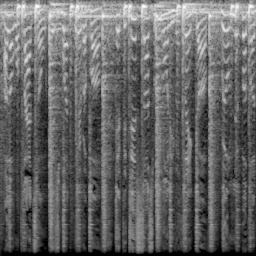title: Audio Diffusion
emoji: 🎵
colorFrom: pink
colorTo: blue
sdk: gradio
sdk_version: 3.1.4
app_file: app.py
pinned: false
license: gpl-3.0
audio-diffusion 
Apply diffusion models to synthesize music instead of images using the new Hugging Face diffusers package.
UPDATES:
22/10/2022. Added DDIM encoder and ability to interpolate between audios in latent "noise" space. Mel spectrograms no longer have to be square (thanks to Tristan for this one), so you can set the vertical (frequency) and horizontal (time) resolutions independently.
15/10/2022. Added latent audio diffusion (see below). Also added the possibility to train a DDIM (De-noising Diffusion Implicit Models). These have the benefit that samples can be generated with much fewer steps (~50) than used in training.
4/10/2022. It is now possible to mask parts of the input audio during generation which means you can stitch several samples together (think "out-painting").
27/9/2022. You can now generate an audio based on a previous one. You can use this to generate variations of the same audio or even to "remix" a track (via a sort of "style transfer"). You can find examples of how to do this in the test_model.ipynb notebook.
DDPM (De-noising Diffusion Probabilistic Models)
Audio can be represented as images by transforming to a mel spectrogram, such as the one shown above. The class Mel in mel.py can convert a slice of audio into a mel spectrogram of x_res x y_res and vice versa. The higher the resolution, the less audio information will be lost. You can see how this works in the test_mel.ipynb notebook.
A DDPM is trained on a set of mel spectrograms that have been generated from a directory of audio files. It is then used to synthesize similar mel spectrograms, which are then converted back into audio.
You can play around with some pre-trained models on Google Colab or Hugging Face spaces. Check out some automatically generated loops here.
| Model | Dataset | Description |
|---|---|---|
| teticio/audio-diffusion-256 | teticio/audio-diffusion-256 | My "liked" Spotify playlist |
| teticio/audio-diffusion-breaks-256 | teticio/audio-diffusion-breaks-256 | Samples that have been used in music, sourced from WhoSampled and YouTube |
| teticio/audio-diffusion-instrumental-hiphop-256 | teticio/audio-diffusion-instrumental-hiphop-256 | Instrumental Hip Hop music |
Generate Mel spectrogram dataset from directory of audio files
Install
pip install .
Training can be run with Mel spectrograms of resolution 64x64 on a single commercial grade GPU (e.g. RTX 2080 Ti). The hop_length should be set to 1024 for better results.
python scripts/audio_to_images.py \
--resolution 64,64 \
--hop_length 1024 \
--input_dir path-to-audio-files \
--output_dir path-to-output-data
Generate dataset of 256x256 Mel spectrograms and push to hub (you will need to be authenticated with huggingface-cli login).
python scripts/audio_to_images.py \
--resolution 256 \
--input_dir path-to-audio-files \
--output_dir data/audio-diffusion-256 \
--push_to_hub teticio/audio-diffusion-256
Train model
Run training on local machine.
accelerate launch --config_file config/accelerate_local.yaml \
scripts/train_unconditional.py \
--dataset_name data/audio-diffusion-64 \
--hop_length 1024 \
--output_dir models/ddpm-ema-audio-64 \
--train_batch_size 16 \
--num_epochs 100 \
--gradient_accumulation_steps 1 \
--learning_rate 1e-4 \
--lr_warmup_steps 500 \
--mixed_precision no
Run training on local machine with batch_size of 2 and gradient_accumulation_steps 8 to compensate, so that 256x256 resolution model fits on commercial grade GPU and push to hub.
accelerate launch --config_file config/accelerate_local.yaml \
scripts/train_unconditional.py \
--dataset_name teticio/audio-diffusion-256 \
--output_dir models/audio-diffusion-256 \
--num_epochs 100 \
--train_batch_size 2 \
--eval_batch_size 2 \
--gradient_accumulation_steps 8 \
--learning_rate 1e-4 \
--lr_warmup_steps 500 \
--mixed_precision no \
--push_to_hub True \
--hub_model_id audio-diffusion-256 \
--hub_token $(cat $HOME/.huggingface/token)
Run training on SageMaker.
accelerate launch --config_file config/accelerate_sagemaker.yaml \
scripts/train_unconditional.py \
--dataset_name teticio/audio-diffusion-256 \
--output_dir models/ddpm-ema-audio-256 \
--train_batch_size 16 \
--num_epochs 100 \
--gradient_accumulation_steps 1 \
--learning_rate 1e-4 \
--lr_warmup_steps 500 \
--mixed_precision no
DDIM (De-noising Diffusion Implicit Models)
A DDIM can be trained by adding the parameter
--scheduler ddim
Inference can the be run with far fewer steps than the number used for training (e.g., ~50), allowing for much faster generation. Without retraining, the parameter eta can be used to replicate a DDPM if it is set to 1 or a DDIM if it is set to 0, with all values in between being valid. When eta is 0 (the default value), the de-noising procedure is deterministic, which means that it can be run in reverse as a kind of encoder that recovers the original noise used in generation. A function encode has been added to AudioDiffusionPipeline for this purpose. It is then possible to interpolate between audios in the latent "noise" space using the function slerp (Spherical Linear intERPolation).
Latent Audio Diffusion
Rather than de-noising images directly, it is interesting to work in the "latent space" after first encoding images using an autoencoder. This has a number of advantages. Firstly, the information in the images is compressed into a latent space of a much lower dimension, so it is much faster to train de-noising diffusion models and run inference with them. Secondly, similar images tend to be clustered together and interpolating between two images in latent space can produce meaningful combinations.
At the time of writing, the Hugging Face diffusers library is geared towards inference and lacking in training functionality (rather like its cousin transformers in the early days of development). In order to train a VAE (Variational AutoEncoder), I use the stable-diffusion repo from CompVis and convert the checkpoints to diffusers format. Note that it uses a perceptual loss function for images; it would be nice to try a perceptual audio loss function.
Train latent diffusion model using pre-trained VAE.
accelerate launch ...
...
--vae teticio/latent-audio-diffusion-256
Install dependencies to train with Stable Diffusion.
pip install omegaconf pytorch_lightning
pip install -e git+https://github.com/CompVis/stable-diffusion.git@main#egg=latent-diffusion
pip install -e git+https://github.com/CompVis/taming-transformers.git@master#egg=taming-transformers
Train an autoencoder.
python scripts/train_vae.py \
--dataset_name teticio/audio-diffusion-256 \
--batch_size 2 \
--gradient_accumulation_steps 12
Train latent diffusion model.
accelerate launch ...
...
--vae models/autoencoder-kl
